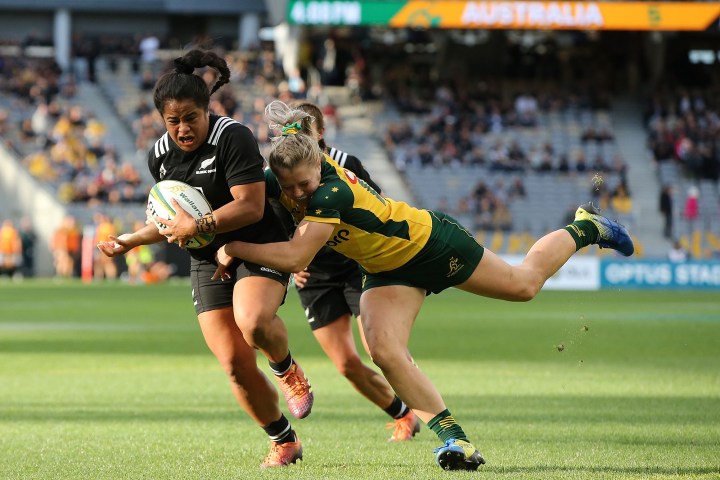DM168 Sport
Gender games: The complex issue of sport categories and why they matter

Global sporting bodies are wrestling with legal, moral and ethical questions over transgender athletes and where they fit in. It’s an emotive issue with no easy answers across a wide range of sporting codes.
First published in the Daily Maverick 168 weekly newspaper.
In October, World Rugby became the first major Olympic sporting code to issue a policy that prevents transgender women from playing women’s rugby. The policy caused seismic tremors in a sporting world that is grappling with the issue. Court cases and legislation in the US, the prospects of the first trans women medalists in the Olympic Games, and a growing lobby on both sides of the issue have created an incendiary climate in which to discuss the philosophy, biology and human rights elements of what is sport’s most complex issue.
Also, in the last month, Caster Semenya announced that she would continue to challenge the World Athletics’ regulations that compel her to lower her testosterone levels in order to be eligible to compete in her favoured running events.
Next stop, the European Court of Human Rights, after failed attempts at the Court of Arbitration for Sport and the Swiss Federal Tribunal. It is unknown how long the process may take, and it may well be that Semenya’s career as an 800m runner ends while the appeal is ongoing, but her case is another example of how sport is battling with its handling of biological sex and women’s sport.
Trans and DSD
To be clear, Semenya is not trans. Rather, she has a DSD, a Difference of Sex Development, which means she does not use testosterone in the typical way. Women with DSDs differ from trans women in important ways that have some physiological implications, and perhaps more importantly the medical ethics of how a policy is actually implemented for that population. If anything, the DSD case is more complex.
What the trans and DSD issues do share, however, is a principle or physiological premise that demands thought and consideration of why women’s sport exists, and whether inclusion into that category should be considered, and how. World Athletics won the Semenya case because of this principle, and World Rugby’s policy arrived at an evidence-based recommendation that reinforces it.
Simply, it argues that a women’s category “protects” the integrity of the result for biological females and in some instances, the safety of its participants. Biological females do not possess the same physical attributes as males and many of these male-bodied attributes have profound implications for sports performance.
So, while the women who win Olympic medals and world titles would outperform most men in most sports, they are vastly outperformed by the males who win the equivalent Olympic medals and world titles.
In the comparison group that matters, there is literally no contest. Take for instance the fact that the best women runners in history are outperformed every year by hundreds of boys younger than 18, and by many thousands of adult men.
The gap between the respective champions in most track and field disciplines is 10% to 12%, and thousands of biological males fit into that space. As a result, if women’s sport did not exist as a category, women would vanish entirely from elite track and field.
Consider next that a 10% to 12% difference is actually relatively small. In weightlifting, the difference is 30% to 40%. For tasks like serving in tennis, it is 20% and for punching power, the male advantage has been measured at 160%.
These differences are enormous and within a relevant comparison group (like Olympic athletes, or high school athletes competing for scholarships), they are insurmountable.
This is not to say that female athletes do not possess extraordinary abilities, as well as technical and mental skills that are necessary in champions. But male-bodied physiological advantages are so large that all attributes unrelated to biological sex, the ones that should actually matter, are drowned out by things like muscle mass, strength, power, body shape and speed.
The major differentiator
The biological basis for these differences is testosterone. Not exclusively, of course, but primarily, this hormone is responsible for all the changes we easily recognise in young boys as they move through puberty to become adults.
Many have direct implications for sport – more muscle, less fat, a narrower and longer skeleton including larger hands, a larger heart and lungs, and more haemoglobin to transport oxygen around the body. These create more power and speed, greater strength and endurance, and mechanical advantages in sports where height, arm length and hand size matter.
On a biological level, then, women’s sport exists so that we can reward, as equally deserving, two humans who possess “the right stuff” for a given event, even though their performances are different.
When Wayde van Niekerk and Shauna Miller-Uibo both receive Olympic 400m gold medals, sport is saying that it understands that biological sex does not matter to the merits of a performance and that women will be rewarded equally when they express outstanding performances within their group.
To ignore this would be analogous to ignoring weight categories in boxing – the contribution made by skill and technique would be greatly reduced, and “big, heavy and strong” would become the best predictor of boxing performance.
Some lightweight boxers would still win the occasional fight, but only against inferior heavyweights. As soon as other elements of the sport such as skill and speed became more matched, strength and size would become decisive, so lightweights would disappear from the top of the sport.
The dilemma for sport
Now, with all those principles and concepts in mind, consider the dilemma for sport. There are individuals whose biological sex does not match their gender identity. Biological males undergo puberty driven by testosterone, but identify as female. What is their place in sport?
A decent and progressive society accepts them. But can sport accept them into the protected, closed category for women? Given the biological realities, if self-identification or gender identity were the sole criteria, women’s sport would become “open”, and its purpose negated.
This then sets up what is basically a “colliding rights” issue, where the rights of females to have a sporting space of their own collides with the rights of other individuals to identify as they wish. Sport finds itself in the middle of that collision. It becomes, effectively, a question of how various priorities are balanced. Those priorities are inclusion, fairness and, in some sports, safety.
Historically, the approach to this issue has been relatively simple – it tried to “fix” the problem by relying on medication or surgical intervention to lower the testosterone levels in trans women.
Given what we described above regarding testosterone’s crucial role in creating the male-female sporting divide, the premise is that if testosterone is lowered or removed, so is the sporting advantage.
The lowering of testosterone can be achieved either through surgical removal of the testes that produce it, or, as per the most recent Olympic transgender policy, medication that lowers the testosterone below a target level for a period of 12 months.
But this approach is controversial for obvious reasons. Compelling an otherwise healthy individual to use drugs as a requirement to participate, which may have serious side effects, is straddling an uncomfortable ethical line.
Even if the athlete accepts this approach, the acid test, then, is whether the outcome is true. Does the suppression of testosterone take away those differences that women’s sport excludes?
If the answer is “yes”, then sport is in the happy position of achieving inclusion, fairness and safety. But if the answer is “no”, then sport has a dilemma, because those three imperatives can no longer be balanced or held equally by the same policy.
The sport then has to make a choice and prioritise them. It can choose inclusion at the expense of fairness and safety, or it can choose safety and fairness, with a resultant compromise on inclusion.
That is the situation World Rugby found itself in during an expert consultation process early in 2020. The scientific evidence, while limited, is consistent and relatively clear. There are no studies that have shown that suppressing testosterone for 12 months makes a meaningful dent in male physiological advantages relevant to rugby.
All the studies that do exist strongly suggest a retained advantage that makes the testosterone suppression policy ineffective at achieving its objective of fairness.
A dozen such studies have found that strength, muscle mass, and muscle volume decrease by between 5% and 10% when testosterone is lowered. Given that the original male vs female difference is between 30% and 50%, the implication is that a significant part of the original advantage remains when trans women are compared to a matched group of biological females.
There is one study suggesting that male endurance advantages in distance runners are removed entirely, which might allow some sports to balance inclusion and fairness, but for sports where mass, size, strength, power and speed matter, the evidence all points one way, in the direction of retained advantage and the necessity of a prioritisation of those imperatives.
Legalities of the case
That decision is then informed by matters of risk and legal considerations. If player welfare is a priority, then the imposition of foreseeable and unreasonably high risks on a group of players by virtue of, in this case, failing to protect a sex class in sport cannot be justified.
Many countries have gender recognition acts that stipulate that sports can restrict participation, and effectively discriminate on the basis of sex if the sport is “gender affected”, which rugby most certainly is.
While a policy that excludes trans women from playing women’s rugby may invite legal challenges against discrimination, not doing so could invite both discrimination claims by biological females and, possibly, claims that arise out of injuries, potentially serious.
Given that World Rugby regularly states that its number one priority is player welfare, the decision was made, led by the evidence and principle, that trans women cannot currently play elite women’s rugby, with Member Unions given the option to comply or not, depending on local legislation.
Ignorance is not an option
It is an immensely difficult decision, but one that all sports must confront. To date, sporting bodies have appeared to hope that the fix works and have ignored a host of studies that suggest it doesn’t.
Their fallback is often: “there is no research into elite athletes, no evidence of advantages for trans women”. The problem with this approach is twofold.
First, there is now enough evidence in non-athletic groups to suggest a problem that would persist even when elite training is added to the mix. For various technical reasons, training is likely to exacerbate the problem, not remove it. Sports can’t ignore that body of evidence, even if they don’t deem it directly relevant to them.
Second, adopting a position of inclusion on the (false) basis that there is no evidence at all implies that women’s sport should be treated as open, allowing biological males into it and then evidence should be sought to disprove it.
This is certainly an approach that one might defend on the basis of human rights. Others would argue that the category should be closed until evidence is provided to show that opening it can be done without safety and fairness implications for women.
Regardless, this is not a problem that will disappear, and in time, sports may be confronted not only by evidence and principles, but specific high-profile cases, perhaps as soon as the 2021 Olympic Games.
It is not melodramatic to say that the future of women’s sports depends upon how science, human rights and sporting imperatives are managed in this most complex controversy. DM168
You can get your copy of DM168 at these Pick n Pay stores.



















 Become an Insider
Become an Insider
As a layperson I (and several others) had commented briefly on this issue when the ‘defender’ of Caster Semenya ‘case’ wrote a (misguided in my view) article on the matter a few days ago. Prof Tucker in his cogently and lucid argument, confirms our view and position on the matter. While many South Africans especially the ‘politicians’ view the matter as one of ‘patriotism’, Ross has in some ways ‘put a lid’ on that perspective. One aspect not covered or mentioned in Ross’s article, is that this complex issue of how to incorporate transgender persons into their rightfull place in society, is that it does not significantly have an impact on ‘non-professional’ levels of sport. Here the sometimes ‘huge incentives’ of professional sports has been sidelined to great extent. It would be interesting for the professor to elaborate on the issues of what he calls the DSD and Trans conundrum or distinction.
The Science of Sport podcast with Mike Finch and the articles by Ross Tucker provide a trove of insight into these really difficult issues. They are also elegant testimony to the integrity with which Tucker approaches these questions. He was part of Semenya’s team in her challenge before CAS when she was effectively banned from running. The podcasts are on Twitter and Facebook (The Science of Sport) and Ross’s writings are in The Science of Sport on Facebook. All the back episodes can be found there. There’s also a Patreon page which helps sponsor the podcasts. He signs off as ‘Ross’ so please don’t think me arrogant for using his first name.
Failing to protect ‘real women’ will only have one ending, i.e. no ‘real women’ competing.
On the other hand maybe they will create an all-new category, only for ‘real women’, then the cycle will start again.
Best would be to create a new category right now called ‘anything goes’. Any combination of X and Y.
Leave the real mens’ and womens’ events as they are, i.e. XY vs XY and XX vs XX.
There is no other fair option.
I enjoyed this article as it is written from a common sense point of view with no emotions attached. This has become such an emotive issue that it is difficult to have a logical discussion over the matter.